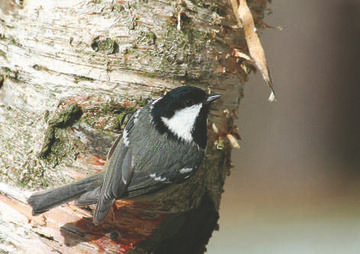
Coal Tit © Sheila Blamire
Some Coal Tits spread out and switch habitats in winter, the maps showing them present in an extra 65 tetrads compared to the breeding season, including some of those in the sparsely-wooded areas mentioned previously. Woodland is still the most favoured habitat although in significantly fewer tetrads (51% of records in winter, 63% during the breeding season) with their liking for conifers maintained, but far fewer birds were reported from scrub (7% of records in winter, 17% during the breeding season) and farmland (7% of records in winter, 13% during the breeding season). More birds were found in farmland hedges (6% of records in winter, 2% during the breeding season), mostly in mixed flocks with other tits and far more Coal Tits were reported from human sites, mainly suburban and rural (38% of records in winter, 29% during the breeding season).
Over 400 submitted records over the three winters included a count of Coal Tits, but more than half of them were of just a single individual, illustrating that the way that most people encounter the species is by finding an odd one amongst a flock of other birds. Even at their regular haunts, groups of more than a few Coal Tits are seldom seen. At feeding stations in Delamere Forest, I have found that Coal Tit numbers vary substantially from year to year, presumably responding to the biennial cycle in the crop of natural seeds, and the number of gardens visited also changes depending on the yield of beech mast (Glue 1982 and BTO Garden Birdwatch data). Where they share feeding areas, this species is subordinate to all of the other tits and woodland feeders and can suffer if there is a dearth of food. Coal Tits avoid this in two ways: their finer bill makes them more able to exploit small food items amongst clusters of pine needles, a resource not available to those with chunkier beaks, and they often hide food in caches during autumn, to be retrieved in later times of shortage.
The description of Coal Tit as one of Britain’s most sedentary species (BTO Second Atlas, BTO Winter Atlas) is probably an overstatement. First-year birds disperse up to a median distance of 11 km from their natal site in midwinter (Migration Atlas), although, once settled in an area, birds probably do tend to stay put. One regular customer at a Delamere Forest feeding station, hatched in 1996 or earlier and ringed in winter 1997/ 98, was caught in seven winters and retrapped when at least nine-and-a-half years old in December 2005.
There are occasional influxes of Coal Tits from continental Europe. Although none has been proven to reach Cheshire and Wirral, one wonders about the origins of the first-year bird ringed on 12 October 1985 at Bardsey Island, Gwynedd and retrapped in a ringer’s garden 136 km away at Little Sutton (SJ37T) on 15 February 1986. Coward (1910) noted that they were more in evidence in the winter months, which he ascribed to probable immigration.
Sponsored by Denise Bebbington

